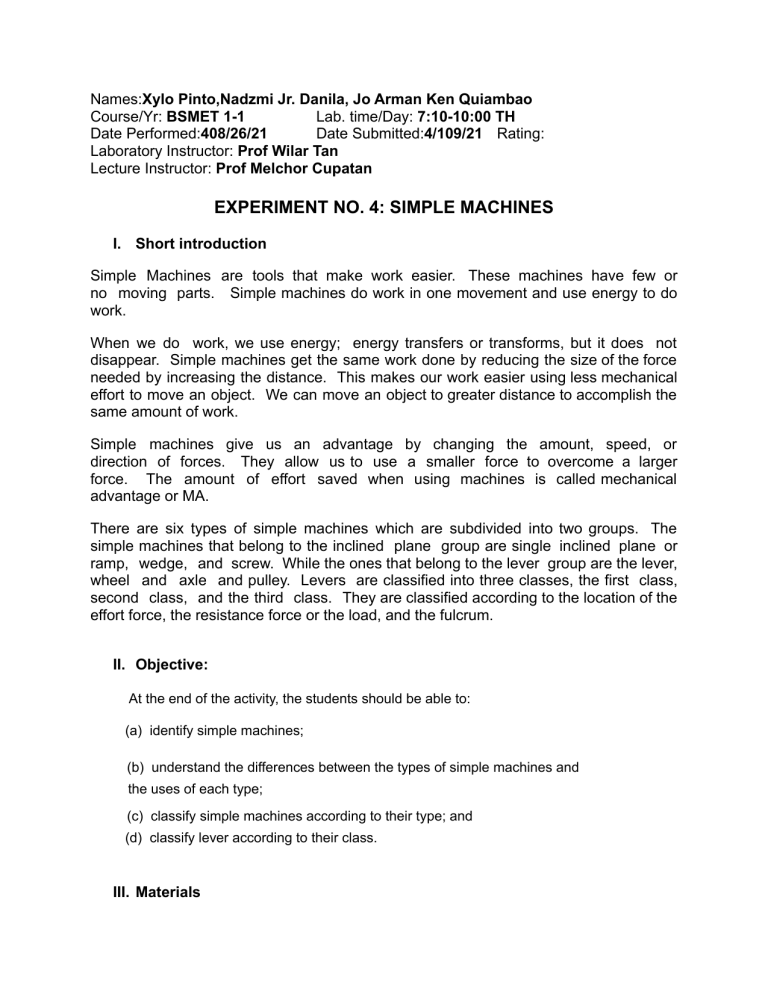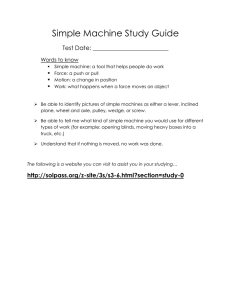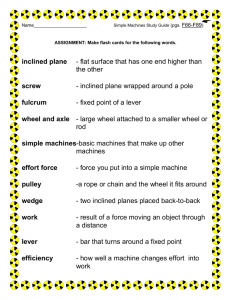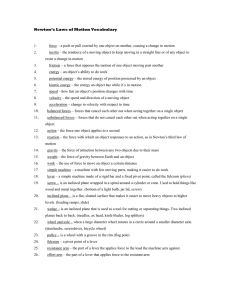
Names:Xylo Pinto,Nadzmi Jr. Danila, Jo Arman Ken Quiambao Course/Yr: BSMET 1-1 Lab. time/Day: 7:10-10:00 TH Date Performed:408/26/21 Date Submitted:4/109/21 Rating: Laboratory Instructor: Prof Wilar Tan Lecture Instructor: Prof Melchor Cupatan EXPERIMENT NO. 4: SIMPLE MACHINES I. Short introduction Simple Machines are tools that make work easier. These machines have few or no moving parts. Simple machines do work in one movement and use energy to do work. When we do work, we use energy; energy transfers or transforms, but it does not disappear. Simple machines get the same work done by reducing the size of the force needed by increasing the distance. This makes our work easier using less mechanical effort to move an object. We can move an object to greater distance to accomplish the same amount of work. Simple machines give us an advantage by changing the amount, speed, or direction of forces. They allow us to use a smaller force to overcome a larger force. The amount of effort saved when using machines is called mechanical advantage or MA. There are six types of simple machines which are subdivided into two groups. The simple machines that belong to the inclined plane group are single inclined plane or ramp, wedge, and screw. While the ones that belong to the lever group are the lever, wheel and axle and pulley. Levers are classified into three classes, the first class, second class, and the third class. They are classified according to the location of the effort force, the resistance force or the load, and the fulcrum. II. Objective: At the end of the activity, the students should be able to: (a) identify simple machines; (b) understand the differences between the types of simple machines and the uses of each type; (c) classify simple machines according to their type; and (d) classify lever according to their class. III. Materials IV. Results A. Identify the simple machine being described. Wheel and Axle a. This reduces the friction of moving objects. Screw b. This holds things together. Pulley c. This uses a rope and can change the direction of a force. Lever d. This is similar to a seesaw that can lift an object. Wedge e. This can split an object apart. Wedge f. This simple machine is found on the head of this ax. Screw g. The bottle cap is an example of this simple machine. Wheel and Axle h. The door knob and rod make up this simple machine. Wheel and Axle i. The screwdriver is an example of this simple machine. Screw j. This is an inclined plane wrapped around a pole. B. On the line by each picture, write the type of simple machine. On which type of simple machine would you find a fulcrum? Explain what a fulcrum is. A fulcrum is used in levers that acts as a supporting point in which the beam pivots. D. Name the lever, identify the class of lever and label the load, effort and fulcrum. Name Class Parts Name Class Parts Tong 3rd Class 1.Load Scissors 1st Class 1.Effort Nutcracker/ Nutshucker 2nd Class 2.Effort 2.Fulcrum 3.Fulcrum 3.Load 1.Effort 2.Load Boat Paddle 1st Class 2.Fulcrum 3.Fulcrum Fishing Rod 3rd Class 1.Effort 2,Fulcrum 1.Effort 3.Load Wheelbarro w 2nd Class 3.Load 1.Effort 2.Load 3.Fulcrum E. Answer the following briefly but intellectually. 1. How is a wedge like an inclined plane? How is it different? A wedge is a tool that has two inclined planes facing out towards each other .The difference is how they are used An inclined plane is a stationary slanted surface that lessens the force needed to go up or down. A wedge, on the other hand, needs to move in order to do its work by taking advantage of the form created by the inclined plane to separate or split objects. 2. is. On which type of simple machine would you find a fulcrum? Explain what a fulcrum A Fulcrum is usually found in a lever. It is the point on which a beam pivots, when an effort is applied, the load must be followed on the other parts. 3. The floor of a bathtub is an inclined plane. Explain. The floor of a bathtub is an inclined plane because it was designed to force water to flow towards the drainage. 4. Why are doorknobs usually placed at the edge of the door, far from the fulcrum? To make it as easy as possible to open and to lessen the amount of force needed to open the door. 5. For you, which among the simple machines is most essential in your everyday life. Explain. 1. We may not be aware of it but the wheel and axle are found in mostly everything that we use, from the mechanical components of our devices, the automobiles we drive, and as simple as our doorknob consist of a wheel and axle. 2. A lever, levers a type of simple machine that allows you to multiply your work. I considered it as the most essential because it is also found in the human body. 3. Wheel and axle are the most essential, especially during this hard time. The present of transportation plays an important role, specifically in times of emergency. Improvements in overall accessibility, such as businesses’ ability to provide goods and services, and people's ability to access education, employment and services, have also had an impact. V. Conclusion In this activity, classifying the differences of each type of simple machine will make you understand their applications in real life. Simple machines are tools used to make work easier through mechanical advantages in which multiplies the forces exerted on a load. These tools namely wedge,inclined plane, screw, wheel and axle, lever and pulley are used to transmit mechanical work from one part of a device to another part decreasing the effort needed. Lastly simple machines like the lever can be classified into three classes depending on where the fulcrum is fixated and the effort applied. References http://www2.phy.ilstu.edu/pte/489.01content/simple_machines/simple_machines.html







